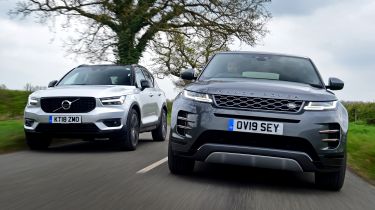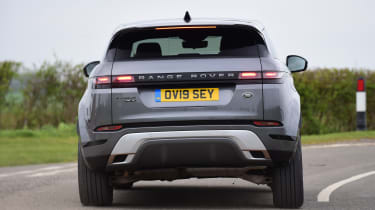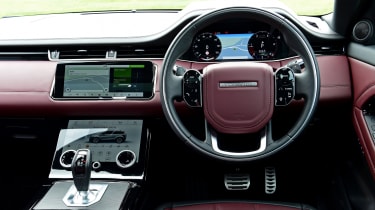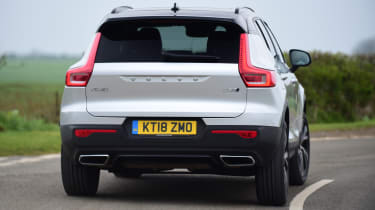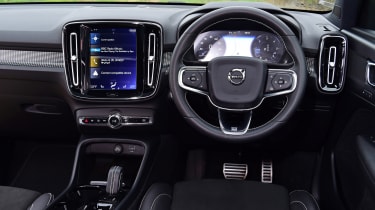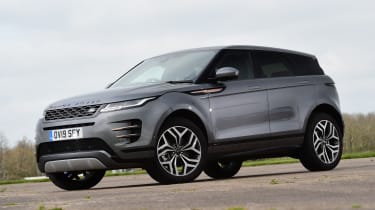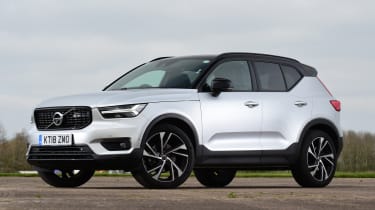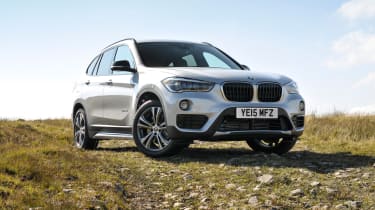Range Rover Evoque vs Volvo XC40
The Range Rover Evoque dominated the small premium SUV market, but Volvo’s XC40 moved it on. Can the new Evoque reclaim its crown?
The Range Rover Evoque was an instant success when it arrived in 2011, claiming our Car of the Year Award. We said at the time: “For a prestige off-road brand to launch a tarmac-focused machine aimed at coupé and saloon car buyers is a brave move, but Land Rover has pulled it off.” In 2019, it seems obvious that most SUV buyers rarely make use of their car’s off-road ability, but Land Rover didn’t abandon its heritage here with the launch of its smallest style-led SUV all those years ago.
The whole project was a brave but lucrative move from the British manufacturer; it has shifted around 800,000 examples of the original model around the world. Yet eight years on, the small premium SUV market had overtaken the original Evoque, despite a few updates since the car’s debut (including the addition of a convertible variant – something that hasn’t quite caught on in the same way).
So now there’s an all-new model that is squaring up against some tough rivals – and here we’re looking at one of the toughest, the Volvo XC40. The Swedish SUV moved the sector on with its luxurious interior and composed driving experience. Can the latest Range Rover Evoque claim back the class it helped to create?
Range Rover Evoque
| Model: |
| |
| Price: | £40,515 | |
| Engine: | 2.0-litre 4cyl diesel, 178bhp | |
| 0-60mph: | 9.7 seconds | |
| Test economy: | 32.6mpg/7.2mpl | |
| CO2: | 150g/km | |
| Annual road tax: | £450 |
The new Evoque has a big name to live up to, but it will also need to beat the impressive XC40 to take victory here. This model is the D180 diesel in R-Dynamic S trim, which costs £40,515 (although our pictures show an R-Dynamic SE).
Used - available now

2023 Land Rover
Range Rover Evoque
25,276 milesAutomaticPetrol1.5L
Cash £28,000
2023 Land Rover
Range Rover Evoque
31,581 milesAutomaticPetrol1.5L
Cash £26,687
2023 Land Rover
Range Rover Evoque
26,722 milesAutomaticPetrol1.5L
Cash £30,163
2023 Land Rover
Range Rover Evoque
35,086 milesAutomaticPetrol1.5L
Cash £26,787Design & engineering
On the outside, the all-new Evoque looks like a clear evolutionary step on (it’s not a big styling departure), but underneath there’s a brand new platform called Premium Transverse Architecture (PTA). This set-up has been designed to accommodate electrification, including plug-in hybrid powertrains in the future. For now, though, there’s a range of petrol and diesel engines to pick from, and it’s the 178bhp 2.0-litre diesel we’re testing here, mated to a nine-speed automatic gearbox and incorporating a mild- hybrid system to boost responses and efficiency. It uses MacPherson-strut front suspension with a multi-link set-up at the back, which is a pretty standard layout in this class, and adaptive dampers are available as an option (£800). Torque vectoring uses the brakes to help make the SUV more agile, while selectable driving modes match the car to the conditions – including off- roading. The Range Rover name would mean little without its history of off-road ability, so the Evoque features the brand’s Terrain Response system, which monitors driving conditions and changes powertrain settings to best match the conditions.
There’s also hill descent control and a 600mm wading depth – and of course, four-wheel drive features, although it’s only active when needed. R-Dynamic S trim comes with 18-inch alloy wheels, LED lights, heated leather seats and sat- nav. The infotainment system measures 10 inches across and gets a WiFi hotspot, connected apps and Android Auto and Apple CarPlay functionality. All models feature a modern interior that boasts premium-looking materials and centres around the large touchscreen display. It’s a big step on from the previous model and the £500 digital instrument cluster and £400 dual infotainment screens add to the modern feel – although the XC40 gets a digital dash as standard that is just as full-featured.
Driving
The Evoque is one of the best drivers’ cars in its class. Its comfortable driving position is instantly noticeable compared with the overly upright seats in the Volvo, and it’s the same story with the steering, which has a pleasing weight that makes the Range Rover feel alert. The rack is quick and turn-in is much sharper than in the XC40, which suffers from light and slightly stodgy steering. The result is that the Evoque has better body control and more grip.
But that performance doesn’t come at the expense of comfort, because the Evoque rides smoothly, too. The £800 adaptive suspension fitted to our car didn’t seem to have too much of an effect on the stiffness, because it was compliant but controlled in both Comfort and Dynamic modes. Just occasionally, the Range Rover does come unstuck, because harsh bumps mid-corner thump the wheels when loaded up, but while the XC40 is slightly smoother, it doesn’t feel as well planted on the tarmac. As the Range Rover gives more confidence to the driver, it doesn’t matter so much that it was a bit slower in a straight line. The sprint from 0-60mph took 9.7 seconds, 0.9 seconds behind the XC40, while the Evoque covered 30-70mph through the gears in 10.1 seconds, trailing its rival by a second.
The D180 engine is a bit rattly when pushed, although at cruising speed, the Range Rover is a lot quieter and more relaxing than its rival. It’s more responsive than the XC40, too, because the mild- hybrid system is able to mask lag in the powertrain.
Practicality
The Evoque has always been a style-focused car, and this new model still features a sharp roofline that tapers at the rear – but it is actually more spacious in the boot than its rival here. For an SUV of this size, the Range Rover’s 472-litre load bay is generous; it’s 12 litres larger than the XC40’s 460-litre boot. Despite the low roofline and panoramic roof on our car, headroom in the rear is good and legroom is acceptable, although the XC40 is a little larger on this latter point.
Ownership
Land Rover doesn’t have the best reputation for reliability, but even so, owners ranked the brand seventh out of 26 manufacturers in our Driver Power 2018 satisfaction survey (the 2019 makers’ chart will be published in our 24 April issue). Less impressive is the 28th place its dealers scored – but at least the new car uses the company’s latest tech in its construction. Safety assistance is a match for its rival here; both cars get lane keep assist and autonomous emergency braking. Like the XC40 the Evoque has seven airbags as standard, including one for pedestrians. And both models scored five Euro NCAP stars in safety testing.
Running costs
If you’re looking for a premium SUV as a company car, the Evoque will be quite a bit more expensive to tax than the XC40. CO2 emissions of 150g/km mean it sits in the top 37 per cent tax bracket, so will cost higher-rate earners £5,910 a year. The 133g/km Volvo sits in the 34 per cent bracket and will cost £5,122 a year to tax. The Range Rover costs a little more to insure for our example driver, at £547 per year compared with £516 for the XC40, and it’s also more expensive to tax because it’s subject to a £310 surcharge every year, thanks to its list price of more than £40,000.
Testers’ notes
“Styling is an Evoque calling card, but that means a small rear window. To improve visibility, Land Rover offers a digital rear-view mirror, giving a wider field of view. It’s clever, but takes some getting used to.”
Volvo XC40
| Model: | Volvo XC40 D4 R-Design Pro |
| Price: | £38,235 |
| Engine: | 2.0-litre 4cyl diesel, 187bhp |
| 0-60mph: | 8.8 seconds |
| Test economy: | 38.0mpg/8.4mpl |
| CO2: | 133g/km |
| Annual road tax: | £140 |
The Volvo XC40 is one of the best cars in its class, and is a key model for the Evoque to beat if it wants to reach the summit of this sector. In top-spec D4 R-Design Pro trim, it costs £38,235 – quite a bit less than the Evoque, despite being closely matched on kit. However, check out our PCP finance deals (how most people buy in this sector), because this significantly levels the playing field.
Design & engineering
Lots of Volvo’s current larger cars, such as the XC60 and V90, are based on the Scaleable Product Architecture (SPA), but the XC40 uses a smaller Compact Modular Architecture (CMA) platform. This is a scalable chassis (the other models that will use it, such as the next V40, haven’t arrived yet) that features MacPherson-strut front suspension and a multi-link layout at the rear. Even though the platform is different, the D4 engine is used throughout Volvo’s line-up. The 2.0-litre diesel has 187bhp and 400Nm of torque, so it’s a little more powerful but a bit less torquey than the Evoque’s motor. There’s an eight-speed automatic gearbox and four-wheel drive, too.
Interior quality is a strong point in modern Volvos, and the XC40 is no exception. While the materials found inside are of lower quality than those in the larger models, the clever way they’re used and a neat dashboard design mean the XC40 feels upmarket, even if it isn’t quite as premium as the Evoque. The infotainment system is very good, but the Range Rover’s looks even more modern, and it shows how quickly the game moves on. In R-Design Pro trim, the Volvo features sat-nav, a digital dash, autonomous braking, parking sensors and LED lights, as well as heated seats and a heated windscreen. A reversing camera is a £375 option and Apple CarPlay and Android Auto functionality costs £300, though. Both are standard on the Evoque.
Driving
Volvo designed the XC40 to deliver a comfortable ride, and it meets that brief. Its supple suspension soaks up the worst bumps and potholes both around town and at higher speed but, while it does strike a good balance between ride and handling, it could be more composed in corners. There’s enough body roll to nibble away at your confidence on country roads, especially as the light steering doesn’t offer any feedback, so it’s hard to be sure of how much grip is available. It’s a contrast to the more agile Range Rover. Still, few owners will drive these cars really hard, so the focus on comfort is easy to justify.
The 2.0-litre D4 diesel is actually quieter than the Evoque’s when driving normally, because it’s well isolated from the cabin and less gruff. But road and wind noise are much more of an issue in the XC40, and at 70mph there is a big deficit here in terms of refinement. The gearbox is smooth overall, but isn’t as quick to change as we’d like in some situations, such as when you slow down and then need to speed up again quickly. This is also an issue with the Range Rover’s nine-speed box, but to a lesser extent.
The extra power and lower weight worked in the XC40’s favour in our performance tests, where the Swedish model was around a second quicker from 0-60mph and 30-70mph. However, longer gearing meant it was slightly slower than the Evoque from 50-70mph in fifth, sixth, seventh and eighth gears.
Practicality
The Volvo’s tall roofline and upright seats mean there’s plenty of head and legroom in the back, and there’s more light inside than you’ll find in the Range Rover. You get a decent amount of in-cabin storage, too, so there’s not much between these two rivals for interior space.The XC40 offers a little more passenger space, even if its 460-litre boot is smaller than the Evoque’s. Have a look at the two load spaces and you’ll see the XC40’s load lip is higher up, so might be harder to lift items into. Still, both cars have flat load lips, which should help with sliding heavy items in and out, plus the Volvo’s boot is also a more useful shape than its rival���s and features a deeper underfloor section.
Fold down the seats and the XC40 has 1,336 litres available, so it’s a little more versatile than the Range Rover (1,156 litres) for maximum carrying capacity, but this is a secondary concern. The Volvo is able to tow 100kg more than its rival, too, at 2,100kg in total.
Ownership
Volvo managed 13th place in our Driver Power 2018 manufacturers’ chart, while its garage network ranked ninth in the dealer survey. Autonomous braking with pedestrian detection and lane-keep assist are standard, as are seven airbags and oncoming lane mitigation. The XC40 scored five stars in Euro NCAP safety tests, just like the Evoque. It might also be worth specifying the IntelliSafe Surround pack (£600), which adds blind spot warning, cross-traffic alert and auto braking that works in reverse gear.
Running costs
Both of these upmarket models will hold their value pretty well. The XC40 is predicted to retain 48.6 per cent of its price after three years or 36,000 miles, according to our experts. That means it will be worth £18,575, having shed £19,660 of its asking price over this period. The Range Rover fares even better, keeping hold of 55.3 per cent of its value in the same time, losing £18,106. That means the Evoque will be worth £22,409 at the end of a typical ownership period. The XC40 managed 38.0mpg, which translates to an annual fuel cost of £1,875. The Evoque returned 32.6mpg, which will cost £2,185 over 12,000 miles.
Testers' notes
“Both of these models were designed with electrification in mind, but there are no plug-in models in the range just yet. For now, diesel makes the most sense for keeping running costs down.”
Verdict
First place: Ranger Rover Evoque
The Evoque mixes comfort and refinement with confidence-inspiring handling, so it’s great to drive. It has a superb interior, too, thanks to the high-quality materials and the availability of plenty of hi-tech kit. It adds practicality into the mix with a big boot and decent rear passenger space. Despite these talents it’s a close finish, because it’s expensive next to the XC40, but PCP affordability helps.
Second place: Volvo XC40
From behind the wheel the XC40 can’t match the Evoque because it doesn’t balance ride and handling as well. Still, it’s almost as practical and the D4 engine is strong. It’s also cheaper despite having a bit more standard kit. The Volvo came second here because the Evoque offers a more convincing premium package for the money, but the XC40 is a fine choice for a more cost-conscious buyer.
Also consider...
Model: Audi Q3 40 TDI S linePrice: £36,870Engine: 2.0-litre 4cyl, 187bhp
The new Audi Q3 beat the XC40 when we tested them together. A 40 TDI model will soon be available; this will match the Volvo’s power output and beat the Evoque’s, although in mid-spec S line trim it will be cheaper than both. It could be a strong contender.
Model: BMW X1 xDrive20d M SportPrice: £36,975Engine: 2.0-litre 4cyl, 187bhp
The BMW X1 offers a great balance of ride and handling, and its 187bhp engine is smoother than both the motors in our test cars. It’s not quite as practical, however, which limits its appeal – although like the Audi Q3, it’s cheaper (even in top-spec M Sport specification).
Figures
| Model: | Range Rover Evoque D180 R-Dynamic S | Volvo XC40 D4 R-Design Pro |
| On the road price/total as tested | £40,515/£40,515 | £38,235/£38,235 |
| Residual value (after 3yrs/36,000) | £22,409/55.3% | £18,575/48.6% |
| Depreciation | £18,106 | £19,660 |
| Annual tax liability std/higher rate | £2,955/£5,910 | £2,561/£5,122 |
| Annual fuel cost (12k/20k miles) | £2,185/£3,642 | £1,875/£3,125 |
| Insurance group/quote/road tax cost | 30/£547/£450 | 30/£516/£140 |
| Cost of 1st/2nd/3rd service | N/A | £285/£455/£285 |
| Length/wheelbase | 4,371/2,681mm | 4,425/2,702mm |
| Height/width | 1,649/1,996mm | 1,658/1,910mm |
| Engine | 4cyl in-line/1,999cc | 4cyl in-line/1,969cc |
| Peak power/revs | 178/2,400 bhp/rpm | 187/4,000 bhp/rpm |
| Peak torque/revs | 430/1,750 Nm/rpm | 400/1,750 Nm/rpm |
| Transmission | 9-speed auto/4wd | 8-speed auto/4wd |
| Fuel tank capacity/spare wheel | 54lt/£165 (space saver) | 54 litres/repair kit |
| Boot capacity (seats up/down) | 472/1,156 litres | 460/1,336 litres |
| Kerbweight/payload/towing weight | 1,816/674/2,000kg | 1,698/515/2,100kg |
| Turning circle | 11.6 metres | 11.4 metres |
| Basic warranty (miles)/recovery | 3yrs (unlimited)/3yrs | 3yrs (60,000)/3yrs |
| Driver Power manufacturer/dealer pos. | 7th/28th | 13th/9th |
| NCAP: Adult/child/ped./assist/stars | 94/87/72/73/5 (2019) | 97/87/71/76/5 (2018) |
| 0-60/30-70mph | 9.7/10.1 secs | 8.8/9.1 secs |
| 30-50mph in 3rd/4th | N/A/3.7 secs | 3.7/4.7 secs |
| 50-70mph in 5th/6th/7th/8th/9th | 5.7/6.4/7.5/10.2/15.9s | 6.2/7.5/9.9/13.6s/N/A |
| Top speed/rpm at 70mph | 127mph/1,650rpm | 130mph/1,600rpm |
| Braking 70-0/60-0/30-0mph | 52.5/36.8/10.4m | 46.9/35.6/9.3m |
| Noise outside/idle/30/70mph | 70/44/60/73dB | 72/47/62/79dB |
| Auto Express econ. (mpg/mpl)/range | 32.6/7.2/387 miles | 38.0/8.4/451 miles |
| WLTP combined mpg | 38.4-41.3mpg | 39.8-44.1mpg |
| WLTP combined mpl | 8.5-9.1mpl | 8.8-9.7mpl |
| Actual/claimed CO2/tax bracket | 232/150g/km/37% | 199/133g/km/34% |
| Airbags/Isofix/park sensors/camera | Seven/yes/yes/yes | Seven/yes/yes/£375 |
| Auto box/lane-keep/blind spot/AEB | Yes/yes/£1,000*/yes | Yes/yes/£600^/yes |
| Clim/cruise ctrl/leather/heated seats | Yes/yes/yes/yes | Yes/yes/yes/yes |
| Met paint/LEDs/keyless/pwr tailgate | £640/y/£400/£415 | £575/y/y/£650^^ |
| Nav/digital dash/DAB/connected apps | Yes/£500/yes/yes | Yes/yes/yes/yes |
| Wireless charge/CarPlay/Android Auto | £132/yes/yes | £175/£300**/£300** |
